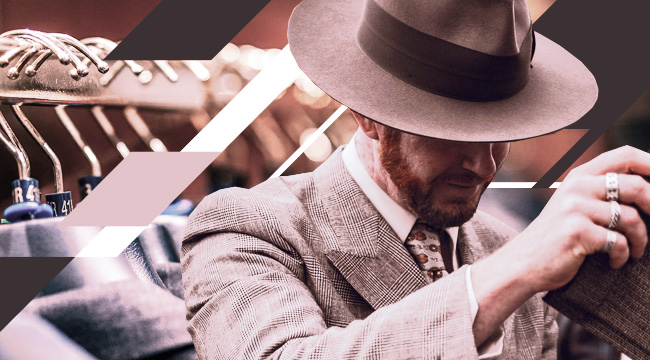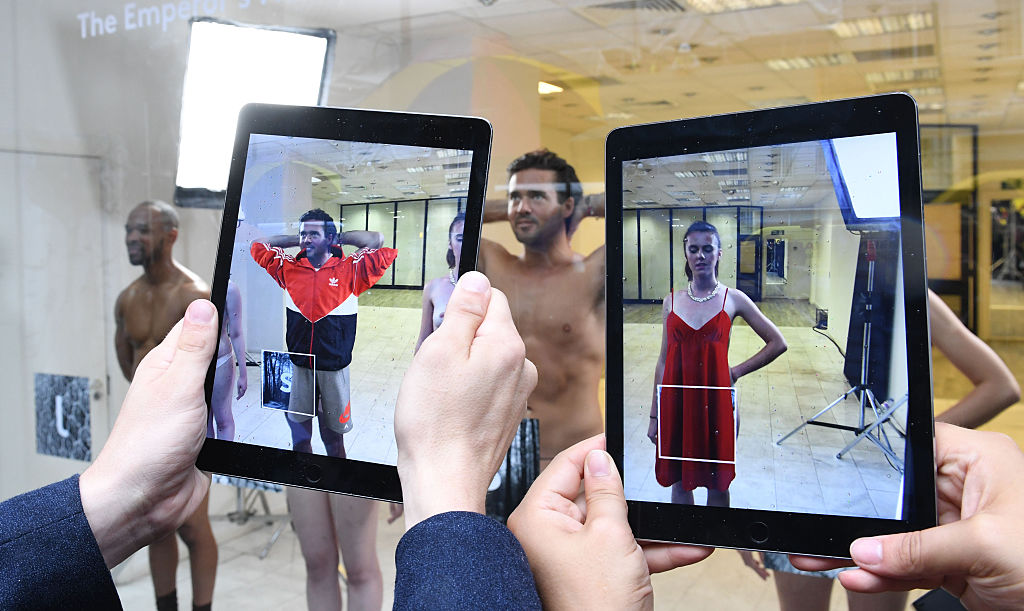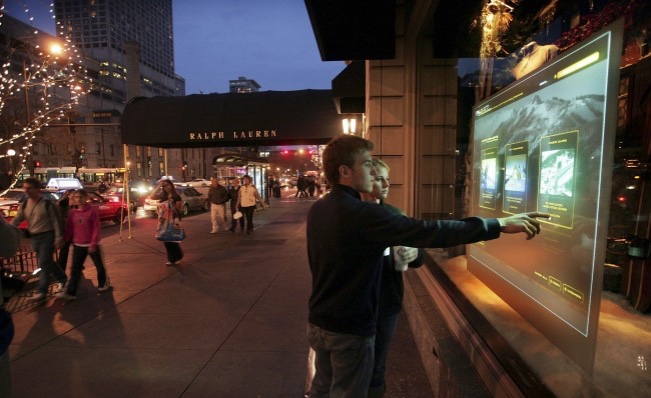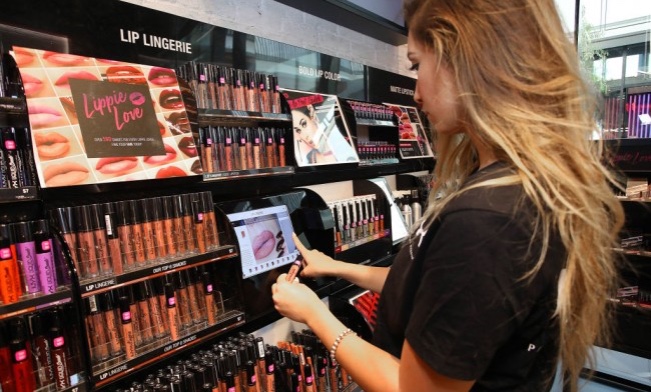
This January, Amazon patented a “blended reality” mirror. The mirror relies on cameras and projectors, layering pixels onto your image in real time — potentially allowing shoppers in the dressing room to see clothing on themselves that they never actually put on (and to see themselves wearing it in any location). If this concept sounds too futuristic to be true, you should note that it’s just one of the innovations coming this year, as shopping and tech collide in increasingly innovative ways. With stores and brands racing to embrace the future, it’s clear that AR, or augmented reality, is about to be a huge part of your shopping experience.
While virtual reality delivers you to a whole new world, AR blends technology with your reality — enhancing it rather than fully altering it. This is ideal for brick and mortar retailers who want to make visiting a physical store more attractive and fun. And new pieces of tech — like Amazon’s mirror — usher in scores of fascinating possibilities. Imagine getting to see how your outfit will pair with the colors of the space you’ll actually wear it in. Or how your date’s outfit will match. Plus, it could be a huge time saver. Rather than having to retry several different combinations of clothing to decide which pants look best with which shirt, you could try them all once. Then mix and match in the mirror — in seconds.
“You’ve tried on a shirt, and so you trust the fit of it. You understand what the materials feel like,” retail expert Melissa Gonzalez explains, “but it’s more helpful to be able to press a button and see all the color options than changing your shirt nine times.”
Gonzalez is the author of the book, The Pop-Up Paradigm: How brands build human connections in a digital age. She’s also the founder of the pop-up firm, Lion’esque — which often utilizes new technology for retailers looking to try something fresh. With the expanding of AR and AI in retail, she tells us, the possibilities are literally boundless.
“Experiential technology is definitely a big part of the retail conversation,” she says. “And it’s exciting.”

Hoping to drive customers back into physical stores, big brands are experimenting more and more with the integration of technology that will create an interactive and immersive experience for customers — combining the convenience of shopping online with human connection and tangible products. Over the last several years, the focus of shopping-based technology has been devoted to making it easier to shop online. We’ve gotten used to the convenience of being able to browse from the comfort of our homes, and then, have products delivered cheaply and quickly to our doorsteps. But there are downsides to shopping online too. Studies show that customers want more personalized experiences. They expect service and connection. And that desire may bring people back into real-life stores.
Once they arrive, however, customers want the same level of “you might like X because you liked Y!” support they get online. The lack of personal knowledge can make a visit to a department store feel less convenient. Don’t they know how much I hate khaki? With AR, your data, preferences, and history can be added back into the storefront experience — allowing employees to tailor the experience to you. AI in stores (in combination with augmented reality) could allow them to suggest products you have a history of buying. Want to add a belt? Instead of having to look through every option (or even leave the dressing room) the tech could know the kinds of belts you’d prefer, throwing you just a few, more personalized suggestions.
“Brands have gotten to where they’ve collected a robust amount of data,” Gonzalez says. “That’s helping them make smarter decisions about the colors that they offer or the size that makes sense. It tells them the neighborhood that they should be in and it can really tailor the experience in a more personalized way.”

Already, AR is showing up in stores — helping customers find that “more personalized” experience. Target has an app with an option to take a picture of the space you want to put a new piece of furniture in. With its help, it’s easy to scan an item and instantly see what it would look like in your living room. That blend of being able to experience a product in person — while also feeling confident that it fits your personal needs —is becoming increasingly common.
In order to compete with e-commerce sales, brands have to make the experience of being in a store more convenient than it used to be — a factor that drove many to shift their shopping to online outlets. These days, they’re using AR to make finding what you want easier. For instance, Walgreen’s has a mapping app that can guide you through your shopping list, pointing you to where you need to go. It’s another way AR can make the shopping experience a less hectic activity.
“People don’t want to have a cluttered show floor experience,” Gonzalez says. “So, you’re seeing reformation in stores where they can have their top sellers on the main selling floor and they have iPads to browse. The store can then actually have more inventory downstairs that they can run up to you.”
Incorporating an easier browsing experience with the instant gratification of seeing a product in person is becoming more common. Shoe stores especially benefit from this model (as traditionally — they’ve had to have a ridiculous amount of storage space for all those boxes). But if stores only need to keep one of each size, you can try a shoe for fit and style, and then have a brand new, untouched pair sent to your house in a day or even just a few hours. Reducing the amount of product and storage space needed at a store has allowed retailers to shift what they can offer in a shopping experience — adding things like coffee shops or lounges.
“I think there is a lot of rethinking happening when digital natives enter the brick and mortar market for the first time about what they can do to drive a sense of urgency and demand that makes people feel like they are getting something unique,” Gonzalez says. “Online shopping is very transactional and — while it can be somewhat aspirational with social media and imagery — it can’t completely satisfy that human gap that people crave.”

In the future, the integration of augmented reality and AI into stores could lead to a much more personalized and immersive shopping experience — with retailers being able to predict our needs in ways we never expected. It’s exciting, but at the same time, there’s still some discomfort in knowing the amount of data that stores might use in the process. This is something brands and customers will need to address moving forward, Gonzalez says. How much privacy do we want to offer up in order to make our lives easier and make shopping more personalized? Trust is something she thinks will be hugely important. Trust in how they collect and use our information, as well as trust that the augmented reality they show us is true.
“It’s an interesting dance,” she says. “But I think that as long as data is being used in a way to surprise and delight us, it will feel helpful.”
It’s all about using AR in a purposeful way to actually benefit the masses. As a tool, tech can do everything from cutting time down in the dressing room to helping us navigate the store more efficiently to allowing us to see products in the actual places we’ll use them. For consumers, that could enhance and revitalize the brick and mortar retail industry. And, like Gonzalez says, as long as the new AR technology in retail continues to surprise and delight us (and as long as it keeps our trust) it’s sure to make our lives easier in ways we never imagined possible.






